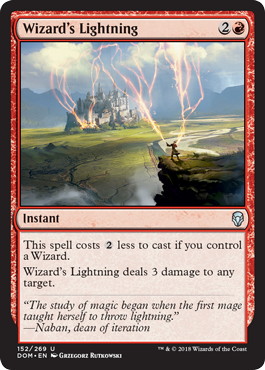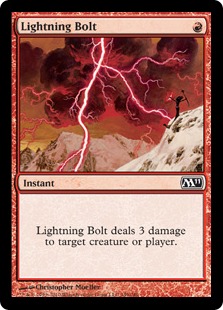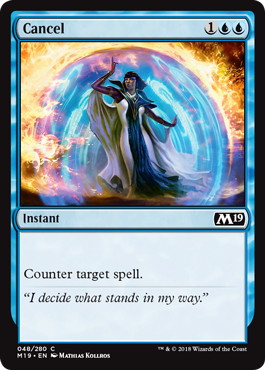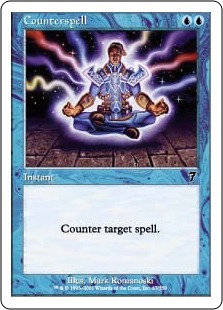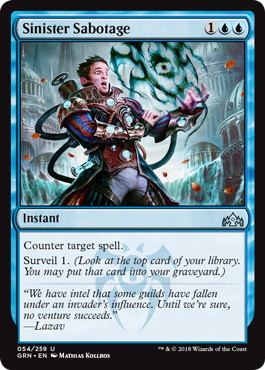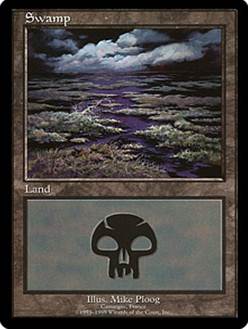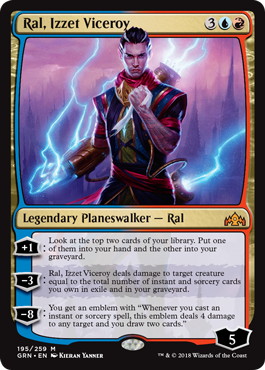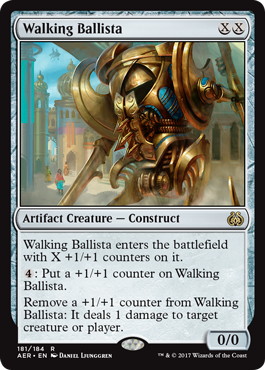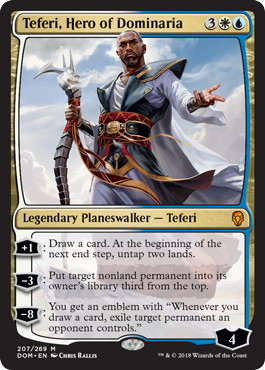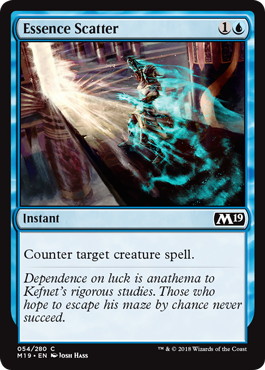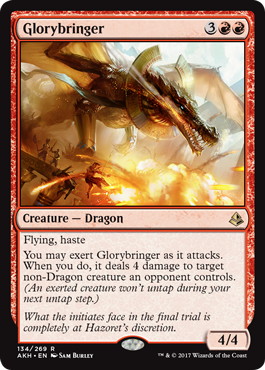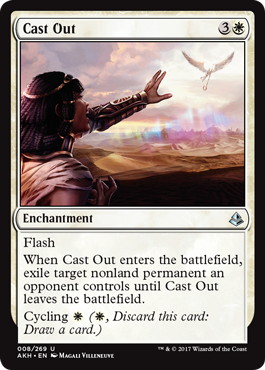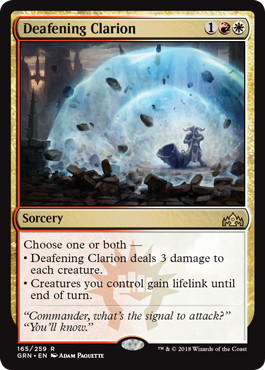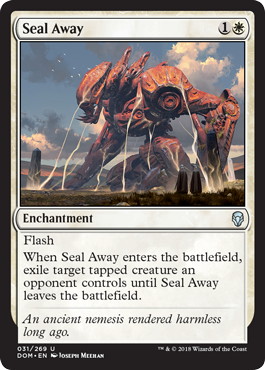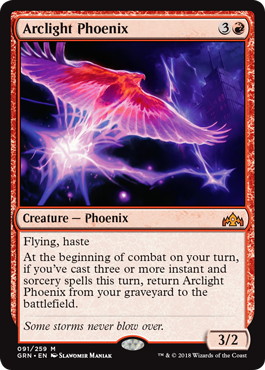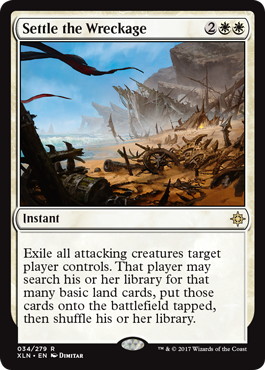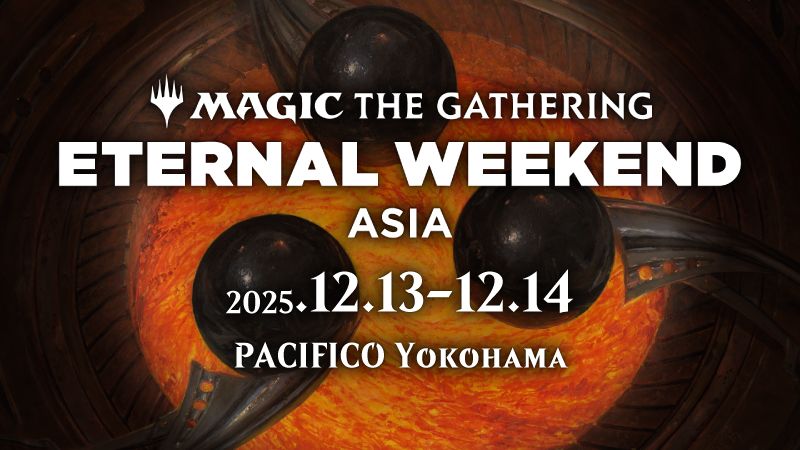Look for the Limits
You’re playing against a control deck. The game has begun to slip away from your hands. The opponent has successfully dealt with your initial onslaught and managed to stabilize at a low life total. The game has been close, and you were almost able to finish them off, but they found a way to get back into it.
You topdeck a lethal 《Wizard's Lightning》 and feel a tiny bit of hope. If that 《Wizard's Lightning》 resolves, you win the game. You feel the urge to act quickly. If you wait, you’re only giving them more time to draw an answer. If you cast it now, maybe you can steal the match before they draw a counterspell. You decide to go for it.
It gets countered. Two turns later, the same thing happens. You draw a second 《Wizard's Lightning》, play it, and it gets countered as well. Then they cast a 《Niv-Mizzet, Parun》, untap with it and run away with the game.It’s a very natural instinct to try to mise a victory there when it seems like the game is getting further and further out of control. And it’s true that as a general rule, the further behind you are the bigger risks you should take to try to win. But taking risks isn’t always necessary. In scenarios like the one described above, you have more control over the game than is immediately obvious.
Let’s look at a simple example to demonstrate this. Let’s say that you have 20 《Mountain》s in play and your opponent has 20 《Island》s. Both of you are empty-handed and you know that the remaining 8 cards in your deck are all 《Lightning Bolt》s, and the remaining 12 cards in your opponent’s deck are all 《Cancel》s. They are at 3 life and get to draw a card first. What should you do?
If you draw one burn spell each turn and cast it immediately, they will get to counter all of them and then you get decked because you have less cards in your library. Instead, you should try to find what factors limit what your opponent can do. In this case the easiest way to bottleneck them on a critical resource is to wait until you have 7 《Lightning Bolt》s in hand and then cast them all on the same turn. Since they can only cast 6 《Cancel》s in a turn, the seventh 《Lightning Bolt》 is bound to resolve.
Let’s change it up a bit and say they have 《Counterspell》s instead of 《Cancel》s. That way they are not limited by mana. The question that leads to the solution is still the same: what are they limited by?
This time they are limited by the maximum hand size. As they can only have a maximum of 7 cards in their hand on your turn, you should wait until you have drawn all the 8 《Lightning Bolt》s in your deck and then cast them on the same turn.
Going back to the 《Wizard's Lightning》 scenario, if the player with the burn spells simply waits with the 《Wizard's Lightning》s in hand, it makes the life of the opponent much harder. As long as you keep the burn spell in hand, it’s essentially a double or triple 《Stone Rain》 because it requires the opponent to keep up the necessary mana for the counterspell at all times. You might still get the same exchange of a 《Negate》 for a 《Wizard's Lightning》 in the end, but at least they had less mana to work with for a while.
If you wait, they have two options: either they develop their board and risk dying to the burn spells you already have, or they give you more time to draw even more of them. In this situation, it’s very possible that the opponent would have had mana for only one counterspell on the turn they cast 《Niv-Mizzet》, and by holding the 《Wizard's Lightning》s you could play both on that turn and win the game.
Not casting your spells is not only relevant in the late game when your opponent is ahead, it can also be beneficial in earlier phases of the game. If you’ve ever played a control deck, you know that when you’re light on lands but have lots of counterspells, the best scenario for you is that your opponent plays only one threat each turn and then at some point gives you a turn of breathing room to cast your card draw spells.
When we were testing for Pro Tour Guilds of Ravnica, one of my teammates wanted to cast an 《Enigma Drake》 against a control opponent who didn’t have many lands but had a lot of cards in hand. Having been on the opposing side so many times, I knew that casting the Drake on that turn is exactly what the opponent wants us to do (especially if he has a 《Sinister Sabotage》 that lets him dig for more lands). A turn or two later we drew into a second 《Enigma Drake》 and then cast them both on the same turn. The opponent was only able to counter one of them, and we protected the other one with 《Dive Down》s long enough to win the game.
By the time the Pro Tour rolled around, I had managed to forget my own advice. In a match against Grixis Control, my opponent was short on mana and I already had enough pressure in play. I also had more than enough gas in hand to rebuild after a sweeper, so I thought I could afford to play some crappy dude to bait out a counterspell and maybe shorten the clock by a turn if he had spot removal. That let him use a 《Sinister Sabotage》 to dig for the black mana he was missing to cast a 《Ritual of Soot》 or a 《Golden Demise》.
Fortunately, it didn’t matter, but it was a dumb decision regardless. He needed to cast a sweeper anyway to have a chance in the game, so my play would either make his sweeper even better or let him dig for the black mana. It also weakened my ability to rebuild in case he had more than one sweeper. If he had found the missing mana, he would’ve needed to tap out for a couple turns in a row so the counterspell would’ve been basically useless in the upcoming turns anyway.
The number of cards left in the deck can also be a limiting factor. At the recent World Magic Cup, I had a 《Ral, Izzet Viceroy》 in my team sealed deck. In the three rounds of team sealed, I had multiple games where I couldn’t ultimate the Planeswalker, because by doing so I would deck myself before dealing them lethal damage. Fortunately, the card advantage provided by 《Ral》 was enough to win the games by other means.
Inducing Calculated Risks
Another example can be found in this match from Grand Prix Birmingham 2018 between Martin Juza and Leo Lahonen. The second game never gets to a natural conclusion as they run out of time, but the last 5-10 minutes of the match are quite interesting nonetheless.
Around the 44-minute mark Leo resolves a massive 《Pull from Tomorrow》. He has a hand full of answers against Martin who is basically out of gas. The game seems to be all but over. A couple minutes later, on the 47th minute, Martin draws back-to-back 《Walking Ballista》s. Notice how he doesn’t cast them immediately. He waits until Leo’s 《Teferi, Hero of Dominaria》 is about to ultimate, at which point he is forced to act.
There are a couple different reasons to do so. First and most obvious one is that Martin is hoping to draw a 《Duress》. Leo is very much limited by the number of cards left in his deck, so all that Martin really needs to do to win is to resolve a medium-sized 《Ballista》 to prevent the 《Teferi》 from ultimating. If the 《Ballista》s get answered by removal spells instead of counterspells, he doesn’t care. All he needs is to resolve one of them, and 《Duress》 can help him do that.
The second reason is that Martin might draw another threat and possibly get Leo to use a counterspell on that, clearing the way for the 《Ballista》s. Some might think that this is just about hoping that Leo makes a mistake and about giving him a chance to do so. I see it more as giving him opportunities and reasons to take calculated risks that get punished by the cards you have.
If all of Leo’s cards could cleanly answer all of Martin’s threats, Leo wouldn’t have any concerns here. But because each of his cards can answer a different subset of threats, he sometimes has to make difficult decisions about which answers to use and which to save for later. This brings us to one of the most critical turns of the game, which actually happens before Martin draws his 《Ballista》s.
At around 45 minutes and 40 seconds in the video, Martin draws a 《Glorybringer》 and Leo decides to spend an 《Essence Scatter》 on it instead of a 《Cast Out》. I believe the reason he does so is that 《Cast Out》 is a more versatile answer, so there’s a wider range of potential threat combinations that he can deal with. In this spot 《Essence Scatter》 just happens to be much better against 《Walking Ballista》 specifically.
By waiting, Martin gives an opportunity for a situation like this to happen again. Not just an opportunity to make a mistake, but an opportunity for Leo’s best line to align poorly against the specific threats that Martin has drawn. And if time had not been called, Martin would’ve eventually won a game that looked impossible for him just a couple turns earlier.
Now to be fair, whether Martin waited with the 《Ballista》s or not didn’t really matter in this game. That said, you can still learn a lot by analysing why he made the choices he made. And if you imagine just a simple change in the scenario, Martin drawing the first 《Walking Ballista》 before the 《Glorybringer》, you end up with a situation where the choice to cast 《Walking Ballista》 immediately would have likely cost him the game. Or if Leo had had one more counterspell in his hand and Martin drew a 《Duress》 when 《Teferi》 was at 8 loyalty.
If we return to the 《Wizard's Lightning》 scenario once more, at its core it’s also about inducing a calculated risk. The opponent won’t know whether the card or cards in your hand are lethal burn spells, 《Lava Coil》s waiting for a target, additional lands, or maybe a 《Shock》 that doesn’t do anything by itself. From their point of view, it is very tempting to just cast the 《Niv-Mizzet》 with one counter up and hope to get to untap with it. It’s probably even the right play for them.
Controlling the Flow
Aside from just holding your spells to try to resolve the best ones at the best moments, these lessons can be applied more generally to making it as inconvenient as possible for the opponent to deal with your threats. In my mind, I use the term “controlling the fIow of the game” for this. Control decks of the past used to be able to play almost exclusively at instant speed, but the current Jeskai lists have a lot of cards that need to be cast at specific times and only answer some of the opponent’s threats. That means you can gain a significant edge by doing the right things at the right times.
At the 2018 World Magic Cup, we chose to play Big Red as one of our three decks. One of the reasons for doing so was that Jeskai was supposed to be its worst matchup, and we weren’t even sure if it was unfavourable. A lot of the threats require very different answers.
《Deafening Clarion》 is good against 《Legion Warboss》 and 《Siege-Gang Commander》, but bad against 《Rekindling Phoenix》 and 《Karn, Scion of Urza》. 《Seal Away》 is good against the 《Phoenix》 but weak against 《Warboss》 and useless against 《Karn》. 《Disdainful Stroke》 and 《Negate》 hit 《Karn》 if it’s on the stack but they can’t touch 《Warboss》. If 《Karn》 resolves, the most common answer is 《Teferi》, but if they use the -3 ability you can kill it with a 《Goblin Chainwhirler》 or a token from 《Warboss》.
《Treasure Map》 is also very cheap and doesn’t get hit by the removal, 《Dire Fleet Daredevil》 can sometimes steal an 《Opt》 or a 《Chemister's Insight》 for value, and 《Banefire》 gives the deck incredible reach. With all of that added together, we found that we were winning more than losing against the deck that was supposed to be the worst matchup, as long as we sequenced the threats well and didn’t overextend into a 《Deafening Clarion》.
A Great Lesson
If you want a great lesson on how to control the flow of the game, you should check out the World Magic Cup quarterfinal match between Lee Shi Tian and Ivan Floch, from teams Hong Kong and Slovakia. Lee Shi Tian takes multiple lines of play that might seem unintuitive, but ultimately prevent Ivan from using his cards optimally at any point of the game.
The first one comes on turn 4, when Lee brings back two 《Arclight Phoenixes》 …and doesn’t attack with them. Just to prevent Ivan from having a chance to use his mana effectively on a 《Seal Away》. I don’t think I would’ve even considered that line myself, as even if Ivan has a 《Seal Away》, the other 《Phoenix》 will still get through and deal three. That’s also one less answer to the Drakes, which seem more important threats in the matchup than the 《Phoenixes》. Also, Ivan might just not have a 《Seal Away》, as is the case here. Taking that line really shows how much value Lee puts in having the 《Phoenixes》 as a tool to generate better exchanges later in the game. It’s also true that the Drakes often deal so much damage in one hit, that small bites of damage don’t matter too much.
After that, Floch taps out for a 《Crackling Drake》. The road is clear for Lee to play an 《Enigma Drake》, give it Haste with 《Maximize Velocity》 and attack. Floch goes to 10, after which even a single Drake-hit is very threatening to Floch’s life total and he must play quite carefully for the rest of the game.
On the next turn, Lee plays his 《Crackling Drake》 pre-combat. This puts Ivan in a very awkward spot with his 《Sinister Sabotage》 and 《Settle the Wreckage》. Countering the Drake would leave him with 《Seal Away》 mana up, and Lee might continue playing around it as attacking with everything would be very risky. But if Lee attacks only with the Drake, Floch would either have to chump block with his own Drake or go to a dangerously low life total. Ivan lets it resolve and probably hopes to get a good 《Settle the Wreckage》, but again Lee just passes the turn.
On the following turn, Lee’s 《Beacon Bolt》 is first countered by a 《Negate》, but resolves when Jump-started as Ivan once more can’t afford to tap his mana. Then Lee finally attacks in a way that forces out the 《Settle the Wreckage》.
After Ivan clears the board with double 《Deafening Clarion》 and Lee rebuilds with two 《Crackling Drake》s, Ivan can finally get his 《Teferi》 into play with a 《Settle the Wreckage》 to protect it. With only two 《Settle》s in Ivan’s deck, and one of them already in the graveyard, I think many players would be tempted to attack Floch with both Drakes to deal lethal damage through one 《Seal Away》, and the second 《Settle》 would have been devastating against that line.
However, Lee continues to do what he has done the whole game and tries to minimize the effectiveness of Ivan’s cards. He brings back two 《Phoenixes》 and does a split attack of one Drake to Ivan and one 《Phoenix》 to 《Teferi》. The Drake has to be answered and the three damage from 《Phoenix》 combined with a 《Shock》 would be enough to get rid of the 《Teferi》. This attack is enough to force out the second 《Settle》 without losing too much board presence, while also being good in case Ivan had a 《Seal Away》.
After the 《Settle》, Lee plays out yet another Drake. Floch tries to dig for answers but doesn’t find them. With both 《Settle》s gone, Lee can freely attack with all his creatures and cruise to victory.
Controlling the flow of the game essentially boils down to choosing which battles to fight and when. The “when” part really shows in Lee’s attacks. The first attack comes when Ivan is tapped out and unable to respond. But instead of attacking again on the next turn, he masterfully uses Ivan’s mana as a limiting factor. The threat of his next attack is much like the threat of the lethal 《Wizard's Lightning》 earlier, except that it forces Ivan to keep up a 《Settle the Wreckage》 instead of a counterspell. And just like the 《Wizard's Lightning》 might eventually trade for the same 《Negate》 regardless of when you cast it, the same creatures might get exiled by a 《Settle the Wreckage》 regardless of when you attack. But by waiting you reduce the opponent’s ability to develop their own board state during that time.
This gets us to what is the most important thing I haven’t yet mentioned: the fight over 《Teferi》. One of the easiest ways for Jeskai to win the matchup is to deploy an early 《Teferi》, protect it with 《Seal Away》 for a turn, and untap with it. Funnily enough, in episode 21 of the Pro Points Podcast, Paulo Vitor Damo da Rosa first comments on how he disagrees with Lee Shi Tian about who’s favoured in the Jeskai vs. Drakes matchup (around 24:00), and then later cites this exact play pattern as being one of the reasons why (around 36:00).
But if you watch the game against Floch again, you’ll notice a distinctive pattern: Lee plays in such a way that he can always prevent Ivan from sticking an early 《Teferi》. This is the “choosing which battles to fight” part, and possibly the biggest benefit of not attacking on turn 4. Giving up the guaranteed 3 and possible 6 damage means he has a much safer position in the middle turns of the game. It takes a lot more mana for Ivan to protect a 《Teferi》 against two 《Phoenixes》 than one when Lee has a 《Shock》 in hand. Ivan does eventually manage to land a protected 《Teferi》 in that game, but by that point Lee already has more threats than Ivan can deal with. If Lee hadn’t played as carefully, Ivan might have gotten an opportunity to do that a lot earlier and won the game.
Conclusion
As you can see from Lee Shi Tian’s example, choosing your attacks can be just as important as choosing when to cast your spells and activate your abilities. While it’s always important to try to get the maximum value out of your own cards, it is often just as important to minimize the value they get from theirs (and sometimes they are the same thing). Timing and sequencing your actions correctly can yield tremendous rewards. Hopefully these case studies have given you ideas how to do that!
Matti



